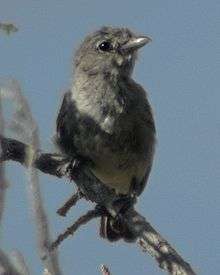Gray vireo
The gray vireo (Vireo vicinior) is a small North American passerine bird. It breeds from the southwestern United States and northern Baja California to western Texas. It is a migrant, wintering in northwestern Mexico, in western Sonora state, and the southern Baja Peninsula in Baja California Sur; it remains all year only in Big Bend National Park in southwest Texas. It is usually found at altitudes between 400 and 2,500 metres (1,300 and 8,200 ft) in its Mexican breeding grounds. This vireo frequents dry brush, especially juniper, on the slopes of the southwestern mountains.[2]
| Gray vireo | |
|---|---|
 | |
| Scientific classification | |
| Kingdom: | Animalia |
| Phylum: | Chordata |
| Class: | Aves |
| Order: | Passeriformes |
| Family: | Vireonidae |
| Genus: | Vireo |
| Species: | V. vicinior |
| Binomial name | |
| Vireo vicinior Coues, 1866 | |
Description
The gray vireo is 14 cm (5 1⁄2 in) in length, gray above, and dull white below, with a single faint wing bar and an eye-ring. It has a short, thick bill. Sexes are similar. The sideways twitching of its tail is unique among vireos and is reminiscent of that of gnatcatchers. The song is hu-wee, chu-wee, che-weet, chee, ch-churr-weet, churr, schray.
Behavior
The gray vireo has skulking habits and is difficult to observe in the dense vegetation it inhabits which is mostly pinyon-juniper woodland or scrub oak woodland. It feeds mainly on insects, and birds that overwinter in Mexico additionally consume fruit. Nests are built within 2 metres (6 ft 7 in) of the ground, often in a thorny tree and consist of dry grasses, plant remains, shreds of bark and spider's web, lined with grasses and fine fibres. A clutch of three or four white eggs is laid and incubated by both parents for about thirteen days. The young leave the nest a fortnight later. Attempted parasitism by the brown-headed cowbird (Molothrus ater) often causes the nest to be abandoned.[2]
References
- BirdLife International (2012). "Vireo vicinior". IUCN Red List of Threatened Species. 2012. Retrieved 26 November 2013.CS1 maint: ref=harv (link)
- Tweit, Robert C. (2005). "Gray vireo". The Texas Breeding Bird Atlas. Retrieved 2014-09-21.
